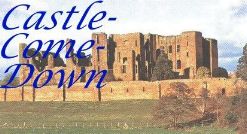|
 Dwight
Peck's lengthy tales Dwight
Peck's lengthy tales
Castle-Come-Down faith
and doubt in the time of Queen Elizabeth I 
EPILOGUE It
would be as well to tie up some of the larger threads left dangling. The Armada
set its sails, as expected, in the summer of 1588, but it was dispersed with terrible
losses by adverse winds and the brilliant seamanship of Drake and Admiral Howard
of Effingham. Several times more King Philip tried mounting new invasions, but
with even less success. In September 1588 the earl of Leicester, who had returned
from the Netherlands to help direct the land defenses, set out for a rest in the
country, and died of an illness at a house of his in Cornbury. Sir Francis Walsingham
died in 1590; Lord Treasurer Burghley lived on until 1598, in which year also
died King Philip II of Spain. Queen Elizabeth died peacefully in the spring of
1603 and was succeeded in her crown by James of Scotland, who in the following
year concluded peace with Spain. In
France, King Henri III continued to fall under the power of the Holy League. Driven
finally to desperation, in December 1588 he lured the duke of Guise to negotiations
at his palace at Blois and had him assassinated by members of the royal bodyguard.
The cities of the League revolted openly and the king allied himself at last with
the Huguenot Henri of Navarre. The prince of Parma invaded France on the League
side. Then in the summer of 1589, the king himself was stabbed to death by a fanatical
priest. Nominally at least, Navarre inherited the throne, which after a period
of civil war and his own conversion to Catholicism he came finally to enjoy, as
Henri IV, in 1594. He too was assassinated, in 1610. Don Bernardino de Mendoza,
in depleted health and almost totally blind, left Paris and returned to Spain
in 1591, where he devoted himself to literary pursuits until his quiet death in
Madrid in August 1604. Sir
Edward Stafford retired from his diplomatic career in 1590 and lived quietly in
the country with his wife Lady Douglass until his death in 1605, predeceasing
her by three years. Thomas Fitzherbert seems for a time to have taken up Arundell’s
role as intermediary between Stafford and Mendoza; in 1596 he became English Secretary
to the king of Spain; in 1602 he was ordained as a priest, in 1613 he became a
Jesuit, and he served as rector of the English college in Rome until his death
in 1640. Thomas Lord Paget died of unknown causes in the first half of 1590, and
Thomas Throgmorton died in 1595. Gilbert Gifford died, still immured in the Bishop’s
Prison, in 1590. Thomas Morgan was imprisoned by the prince of Parma in Flanders
from 1590 to 1592, and soon thereafter was exiled from those territories; in 1595
he was deported from Spain; in 1604 he was imprisoned once again in the Bastille
for his involvement in an intrigue against Henri IV, and nothing is known of him
thereafter. Charles Paget seems to have been allowed to return to England after
Queen Elizabeth’s death, to live out his years peacefully in the country
until he died in 1612. Of the
gentlemen in England, the earl of Oxford continued to live well on the queen’s
largesse until his death in 1604. William Shelley was condemned for high treason
in 1586 for his part in Throgmorton’s business, but was still a prisoner
in the Tower when last heard of in July 1588. Philip Howard, the earl of Arundel,
still in the Tower, was tried belatedly and convicted of treason in 1589; he died
in his cell in 1595. Lord Harry Howard lived in eclipse throughout the reign,
but was readmitted to the court in 1600. His intrigues in aid of the peaceful
succession of King James brought him into long-awaited favor upon the queen’s
death; he was admitted to the Privy Council and in 1604 he was created earl of
Northampton, and became Lord Privy Seal in 1608; he remained unobtrusively a Catholic
until his death in 1614, but had become capable of impressing all observers time
and again with his evident lack of principle. Lord
Paget’s sister, Lady Anne Lee, was buried in December 1590. Roman Catholics
were granted political rights in England in 1829.
 | Go
back to the Preface and Table of Contents |
 Please
do not reproduce this text in any form for commercial purposes. Historical references
for events recreated in this story can be found in D. C. Peck, Leicester's
Commonwealth: The Copy of a Letter Written by a Master of Art of Cambridge (1584)
and Related Documents (Athens: Ohio University Press, 1985). Feedback and
suggestions are welcome, Please
do not reproduce this text in any form for commercial purposes. Historical references
for events recreated in this story can be found in D. C. Peck, Leicester's
Commonwealth: The Copy of a Letter Written by a Master of Art of Cambridge (1584)
and Related Documents (Athens: Ohio University Press, 1985). Feedback and
suggestions are welcome,  .
Written 1973-1989, posted on this site 10 June 2001. .
Written 1973-1989, posted on this site 10 June 2001.

|